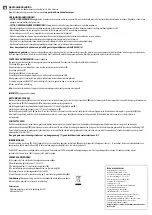
8
MG.60.N1.22
- VLT is a registered Danfoss trademark
VLT
®
5000 / VLT
®
6000
HVAC / VLT
®
8000 AQUA
Collision
Detection
Network
Management
Depending on the level of a given application,
a LonWorks network may or may not require
the use of a network management node. A
network management node performs
management functions, such as:
• Find unconfigured nodes and
download their network addresses.
• Stop, start, and reset node
applications.
• Access node communication statistics.
• Configure routers and bridges.
• Download new applications programs.
• Extract the topology of a running
network.
The LonTalk protocol uses a unique collision
avoidance algorithm which allows an
overloaded channel to carry near to its
maximum capacity, rather than reducing its
throughput due to excessive collisions
between messages. When using a
communications medium that supports
collision detection, such as twisted pair, the
LonTalk protocol can optionally cancel
transmission of a packet as soon as a collision
is detected by the transceiver. This option
allows the node to immediately retransmit any
packet that has been damaged by a collision.
Without collision detection, the node would
wait the duration of the retry time to notice
that no acknowledgment was received. At that
time it would retransmit the packet, assuming
acknowledge or request/response service.
For unacknowledged service, an undetected
collision means that the packet is not received
and no retry is attempted.
knowledgments are generated by the network
host processor without intervention of the ap-
plication. Transaction IDs are used to keep
track of messages and acknowledgments so
that the application does not receive dupli-
cate messages.
An equally reliable service is
request/response
,
where a message is sent to a node or group
of nodes and individual responses are ex-
pected from each receiver. Incoming
messages are processed by the application
on the receiving side before a response is
generated. The same retry and time-out op-
tions are available as with
acknowledged
service. Responses may include data, so that
this service is particularly suitable for remote
procedure call or client/server applications.
Next in reliability is
unacknowledged repeated
.
Messages are sent multiple times to a node
or a group of nodes with no response
expected. This service is typically used when
broadcasting to large groups of nodes when
traffic generated by all the responses would
overload the network.
The final method in reliability is
unac-
knowledged
, where a message is sent once
to a node or group of nodes and no response
is expected. This option is typically used when
the highest performance is required, network
bandwidth is limited, and the application is
not sensitive to the loss of a message.
Message
Passing
(continued)










































